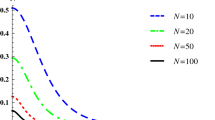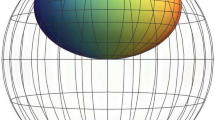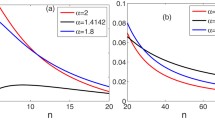Abstract
As early as 1932, Majorana had proposed that a pure permutation symmetric state of N spin-\({\frac{1}{2}}\) particles can be represented by N spinors, which correspond geometrically to N points on the Bloch sphere. Several decades after its conception, the Majorana representation has recently attracted a great deal of attention in connection with multiparticle entanglement. A novel use of this representation led to the classification of entanglement families of permutation symmetric qubits—based on the number of distinct spinors and their arrangement in constituting the multiqubit state. An elegant approach to explore how correlation information of the whole pure symmetric state gets imprinted in its parts is developed for specific entanglement classes of symmetric states. Moreover, an elegant and simplified method to evaluate geometric measure of entanglement in N-qubit states obeying exchange symmetry has been developed based on the distribution of the constituent Majorana spionors over the unit sphere. Multiparticle entanglement being a key resource in several quantum information processing tasks, its deeper understanding is essential. In this review, we present a detailed description of the Majorana representation of pure symmetric states and its applicability in investigating various aspects of multiparticle entanglement.
Similar content being viewed by others
References
Sackett C.A. et al.: Experimental entanglement of four particles. Nature (London) 404, 256–259 (2000)
Roos C.F., Riebe M., Häffner H., Hänsel W., Benhelm J., Lancaster G.P.T., Becher C., Schmidt-Kaler F., Blatt R.: Control and measurement of three-qubit entangled states. Science 304, 1478–1480 (2004)
Leibfried D. et al.: Creation of a six-atom ‘Schrodinger Cat’ state. Nature (London) 438, 639–642 (2005)
Sorensen A., Duan L.-M., Cirac J.I., Zoller P.: Many-particle entanglement with Bose-Einstein condensates. Nature (London) 409, 63–66 (2001)
Usha Devi A.R., Prabhu R., Rajagopal A.K.: Characterizing multiparticle entanglement in symmetric N-qubit states via negativity of covariance matrices. Phys. Rev. Lett. 98, 060501-060504 (2007)
Greenberger D.M., Horne M.A., Shimony A., Zeilinger A.: Bell’s theorem without inequalities. Am. J. Phys. 58, 1131–1143 (1990)
Dicke R.H.: Coherence in spontaneous radiation processes. Phys. Rev. 93, 99–110 (1954)
Majorana E.: Atomi orientati in campo magnetico variabile. Nuovo Cimento 9, 43–50 (1932)
Bloch F., Rabi I.I.: Atoms in variable magnetic fields. Rev. Mod. Phys. 17, 237–244 (1945)
Penrose R.: Shadows of the Mind. Oxford University Press, Oxford (1994)
Mäkelä H., Messina A.: N-qubit states as points on the Bloch sphere. Physica Scripta T 140, 014054 (2010)
Dennis M.R.: Canonical representation of spherical functions: Sylvester’s theorem, Maxwell’s multipoles and Majorana’s sphere. J. Phys. A. Math. Gen. 37, 9487–9500 (2004)
Swain, J.: The MR of spins and the relation between SU(∞) and SDiff(S 2), hep-th/arxiv:0405004
Dennis M.R.: Correlations between Maxwell’s multipoles for Gaussian random functions on the sphere. J. Phys. A. Math.Gen. 38, 1653–1658 (2005)
Zimba J.: “Anticoherent” spin states via the Majorana representation. EJTP 3, 143–156 (2006)
Bastin T., Krins S., Mathonet P., Godefroid M., Lamata L., Solano E.: Operational families of entanglement classes for symmetric N-qubit states. Phys. Rev. Lett. 103, 070503 (2009)
Bastin, T., Mathonet, P., Solano, E.: Operational entanglement families of symmetric mixed N-qubit states, quant-ph/arxiv:1011.1243
Usha Devi, A.R., Sudha, Rajagopal, A.K.: Determining the whole pure symmetric N-qubit state from its parts, quant-ph/arXiv:1003.2450
Usha Devi, A.R., Sudha, Rajagopal, A.K.: Interconvertibility and irreducibility of permutation symmetric three qubit pure states, quant-ph/arXiv:1002.2820
Markham, D.: Entanglement and symmetry in permutation symmetric states, quant-ph/arxiv: 1001.0343
Aulbach M., Markham D., Murao M.: The maximally entangled symmetric state in terms of the geometric measure. New J. Phys. 12, 073025 (2010)
Martin J., Giraud O., Braun P.A., Braun D., Bastin T.: Multiqubit symmetric states with high geometric entanglement. Phys. Rev. A 81, 062347 (2010)
Aulbach, M., Markham, D., Murao, M.: Geometric entanglement of symmetric states and the Majorana representation, quant-ph/arxiv: 1010.4777
Shimony A.: Degree of entanglement. Ann. Phys. NY Acad. Sci. 755, 675 (1995)
Wei T.C., Ericsson M., Goldbart P.M.: Geometric measure of entanglement and applications to bipartite and multipartite quantum states. Phys. Rev. A 68, 042307 (2003)
Rose M.E.: Elementary Theory of Angular Momentum. Wiley, New York (1957)
Dür W., Vidal G., Cirac J.I.: Three qubits can be entangled in two inequivalent ways. Phys. Rev. A 62, 062314 (2000)
Verstraete F., Dehaene J., De Moor B., Verschelde H.: Four qubits can be entangled in nine different ways. Phys. Rev. A 65, 052112 (2002)
Lamata L., León J., Salgado D., Solano E.: Inductive entanglement classification of four qubits under stochastic local operations and classical communication. Phys. Rev. A 75, 022318 (2007)
Maser, A.A., Wiegner, R., Schilling, U., Thiel, C., von Zanthier, J.: A versatile source of polarization-entangled photons, quant-ph/arXiv:0911.5115
Kiesel N., Wieczorek W., Krins S., Bastin T., WeinfurterH. Solano E.: Operational multipartite entanglement classes for symmetric photonic qubit states. Phys. Rev. A 81, 032316 (2010)
Mathonet P., Krins S., Godefroid M., Lamata L., Solano E., Bastin T.: Entanglement equivalence of N-qubit symmetric states. Phys. Rev. A 1, 052315 (2010)
Nielsen M., Chuang I.: Quantum Computation and Quantum Information. Cambridge University Press, Cambridge (2000)
Linden N., Popescu S., Wootters W.K.: Almost every pure state of three qubits is completely determined by its two-particle reduced density matrices. Phys. Rev. Lett. 89, 207901 (2002)
Linden N., Wootters W.K.: The parts determine the whole in a generic pure quantum state. Phys. Rev. Lett. 89, 277906 (2002)
Jones N.S., Linden N.: Parts of quantum states. Phys. Rev. A 71, 012324 (2005)
Walck S.N., Lyons D.W.: Only n-qubit Greenberger-Horne-Zeilinger states are undetermined by their reduced density matrices. Phys. Rev. Lett. 100, 050501 (2008)
Walck S.N., Lyons D.W.: Only n-qubit Greenberger-Horne-Zeilinger states contain n-partite information. Phys. Rev. A 79, 032326 (2009)
Parashar P., Rana S.: N-qubit W states are determined by their bipartite marginals. Phys. Rev. A 80, 012319 (2009)
Parashar P., Rana S.: Reducible correlations in Dicke states. J. Phys. A. Math. Theor. 42, 462003 (2009)
Coleman A.J.: Structure of fermion density matrices. Rev. Mod. Phys. 35, 668 (1963)
Colmenero F., Pérezdel Valle C., Valdemoro C.: Approximating q-order reduced density matrices in terms of the lower order ones I general relations. Phys. Rev. A 47, 971–978 (1993)
Nakatsuji H., Yasuda K.: Direct determination of the quantum-mechanical density matrix using the density equation. Phys. Rev. Lett. 76, 1039 (1996)
Yasuda K., Nakatsuji H.: Direct determination of the quantum-mechanical density matrix using the density equation II. Phys. Rev. A 56, 2648–2657 (1997)
Mazziotti D.A.: Contracted Schrödinger equation: determining quantum energies and two-particle density matrices without wave functions. Phys. Rev. A 57, 4219–4234 (1998)
Mazziotti D.A.: Pursuit of N-representability for the contracted Schrödinger equation through density-matrix reconstruction. Phys. Rev. A 60, 3618–3626 (1999)
Linden, N., Popescu, S., Schumacher, B., Westmoreland, M.: Reversibility of local transformations of multiparticle entanglement Preprint quant-ph/9912039
Bennett C.H., Popescu S., Rohrlich C., Smolin J.A., Thapliyal A.V.: Exact and asymptotic measures of multipartite pure-state entanglement. Phys. Rev. A 63, 012307 (2000)
Wootters W.K.: Entanglement of formation of an arbitrary state of two qubits. Phys. Rev. Lett. 80, 2245 (1998)
Hill S., Wootters W.K.: Entanglement of a pair of quantum bits. Phys. Rev. Lett. 78, 5022 (1997)
Rajagopal A.K., Rendell R.: Robust and fragile entanglement of three qubits: relation to permutation symmetry. Phys. Rev. A 65, 032328 (2002)
Coffman V., Kundu J., Wootters W.K.: Distributed entanglement. Phys. Rev. A 61, 052306 (2000)
Plenio M., Virmani S.: An introduction to entanglement measures. Quantum Inf. Comput. 7, 1–51 (2007)
Horodecki R., Horodecki P., Horodecki M., Horodecki K.: Quantum entanglement. Rev. Mod. Phys. 81, 865–942 (2009)
Hayashi M., Markham D., Murao M., Owari M., Virmani S.: Entanglement of multiparty-stabilizer, symmetric and antisymmetric states. Phys. Rev. A 77, 012104 (2008)
Hayashi M., Markham D., Murao M., Owari M., Virmani S.: The geometric measure of entanglement for a symmetric pure state with non-negative amplitudes. J. Math. Phys. 50, 122104 (2009)
Wei T.-C., Severini S.: Matrix permanent and quantum entanglement of permutation invariant states. J. Math. Phys. 51, 092203 (2010)
Hübener R., Kleinmann M., Wei T.-C., Guillén C.G., Gühne O.: Geometric measure of entanglement for symmetric states. Phys. Rev. A 80, 032324 (2009)
Arecchi F.T., Courtens E., Gilmore G., Thomas H.: Atomic coherent states in quantum optics. Phys. Rev. A 6, 2211 (1972)
Ruskai M.B.: N completeness, N representability, and Geminal expansions. Phys. Rev. A 5, 1336 (1972)
Author information
Authors and Affiliations
Corresponding author
Rights and permissions
About this article
Cite this article
Devi, A.R.U., Sudha & Rajagopal, A.K. Majorana representation of symmetric multiqubit states. Quantum Inf Process 11, 685–710 (2012). https://doi.org/10.1007/s11128-011-0280-8
Received:
Accepted:
Published:
Issue Date:
DOI: https://doi.org/10.1007/s11128-011-0280-8




